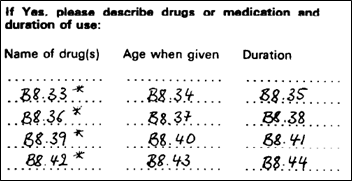Date and time answers
This page is still under construction.
Key Considerations
- Generic times and dates can be used for most entries i.e. ‘Generic Date’.
- Specifically labelled date response domains are created for significant dates, e.g. ‘Date of Birth’.
- Duration is only used for a specific event with a beginning and end.
Date and time (Datetime) answers are used when the response to a question is a date, time or a measurable length of time (Duration).
Common Datetime answers:
Label | Type | Datetime Type | Format (ISO 8601) | Usage |
Generic date | Datetime | Date | None | All date responses except date of birth or death |
Date of birth | Datetime | Date | None | Response to all date of birth questions (cohort member, mother, other relations, etc.) |
Date of death | Datetime | Date | None | Response for all date of death questions (cohort member, mother, other relations, etc.) |
Generic time | Datetime | Time | None | All time responses except time of birth or death |
Time of death | Datetime | Time | None | Response for all time of death questions (cohort member, mother, other relations, etc.) |
Years Months | Datetime | Duration | PnnYnnM | Duration responses expressed in years and months |
Hours Minutes | Datetime | Duration | PTnnHnnM | Duration responses expressed in hours and minutes |
Date answers
Most date responses are entered as a ‘Generic date’ answer. When creating a Date answer, only the Label, Type and Datetime type fields are filled in.
Archivist Build / Response Domains:
Questionnaire: ALSPAC My Teenage Son
Questionnaire layout:
Archivist view (alspac_04_mtsd):
Note: Text included in a question response to indicate the date format ('day month year' in example above) is not entered as part of the question text as the format is implicit in the Date answer. See Transcribing guidance for additional information.
A 'Generic date' answer can be used if the question asks for the day, month, year; month, year; or just the year something occured. Answers to questions that ask for a day only in a month, or month only in a year, cannot be input as a Date answer. They are input as specifically labelled numeric answers. See example.
Specifically labelled Date answers
Specifically labelled Date answers are created only for unique, significant life events, e.g. birth date, death date. Date specific responses about different people (cohort member, mother, partner) do not require the creation of separate Date answers. For example, the same ‘Date of birth’ answer is used for all birth date responses in a questionnaire.
Time answers
Most time responses are entered as a ‘Generic time’ answer. When creating a Time answer, only the Label, Type and Datetime type fields are filled in.
Archivist Build / Response Domains:
The same ‘Generic time’ answer is used regardless of whether the time response in a questionnaire is unformatted or specified - for example ‘hour/minute’ or ‘24 hr clock’.
Questionnaire: HCS Overnight Urine Collection
Questionnaire layout:
Archivist view (hcs_2_clinic_10):
Note: As with date masks, text included in a question response to indicate the time format ('hh mm' in example above) is not entered as part of the question text as the format is implicit in the Time answer. See Transcribing guidance for additional information.
Specifically labelled Time answers
Specifically labelled Time answers are created only for unique, significant life events, e.g. time of birth, time of death. Question responses such as time of interview, test, measurement, sample, admission, completion, etc. are all entered as a ‘Generic time’ answer.
Duration answers
Duration answers are used when a question response requires a period of time answer. In order for a Duration answer to be used it must meet the following criteria:
The time period must be-
- a specific event,
- a continuous period of time,
- sufficiently described, so that the start and end of the event are discrete time points, i.e. there are at least two time elements indicated in the question response (years, months; hours, minutes).
Responses that do not meet the above criteria for a duration answer are entered as numeric answers. Examples of time period responses that are not a duration can be found here.
Duration answers must have the Label, Type, Datetime type and Format fields entered. Text in the question indicating the duration period (e.g. … years, …months) is not included in the question text as the duration period is defined in the duration format field.
The Label should reflect the time elements in the duration, i.e. if a question has a Duration answer expressed in years and months, then the Duration answer would be labelled ‘Years Months’. The Datetime type is input as a ‘Duration’. The Format field defines the period of time contained in the question response using the ISO 8601 standard for displaying a duration. The standard takes the form of ‘PnnYnnMnnDTnnHnnMnnS’. Elements may be omitted if their value is zero, e.g. for an answer expressed as ‘Years Months’ the format would be ‘PnnYnnM’. For an answer expressed as ‘Hours Minutes’ the format would be PTnnHnnM.
Example 1 Questionnaire: ALSPAC Mother’s Lifestyle
Questionnaire layout:
Archivist Build / Reponse Domains:
Archivist view (alspac_96_ml):
Additional examples of questions with Duration answers can be found here.
Duration response with time period unspecified
If a time period response is for a specific event over a continuous period of time, but the response does not specify any time period units (years, months; hours, minutes, etc.), a Duration answer is created with the Format field left blank. The answer Label should reference the response asked about in the question. (i.e. Duration, Time taken).
Example 2 Questionnaire: BCS Parental Interview 1980
Questionnaire layout:
Archivist Build / Response Domains:
Archivist view (bcs_80_pi):
Example 3 Questionnaire: NSHD Pupil’s Questionnaire 1962
Questionnaire layout:
Archivist Build / Response Domains:
Archivist view (nshd_62_cms):




